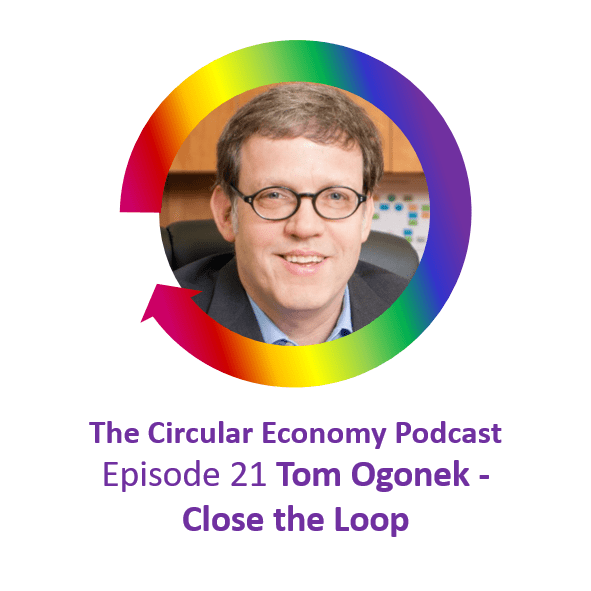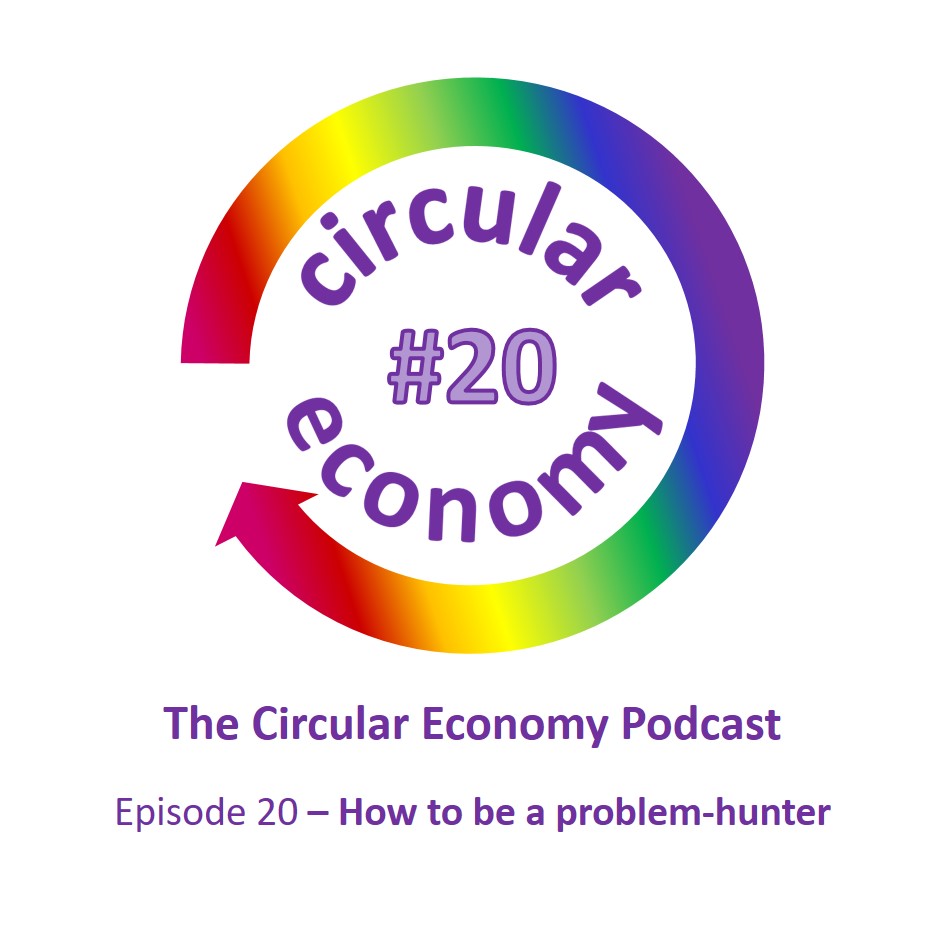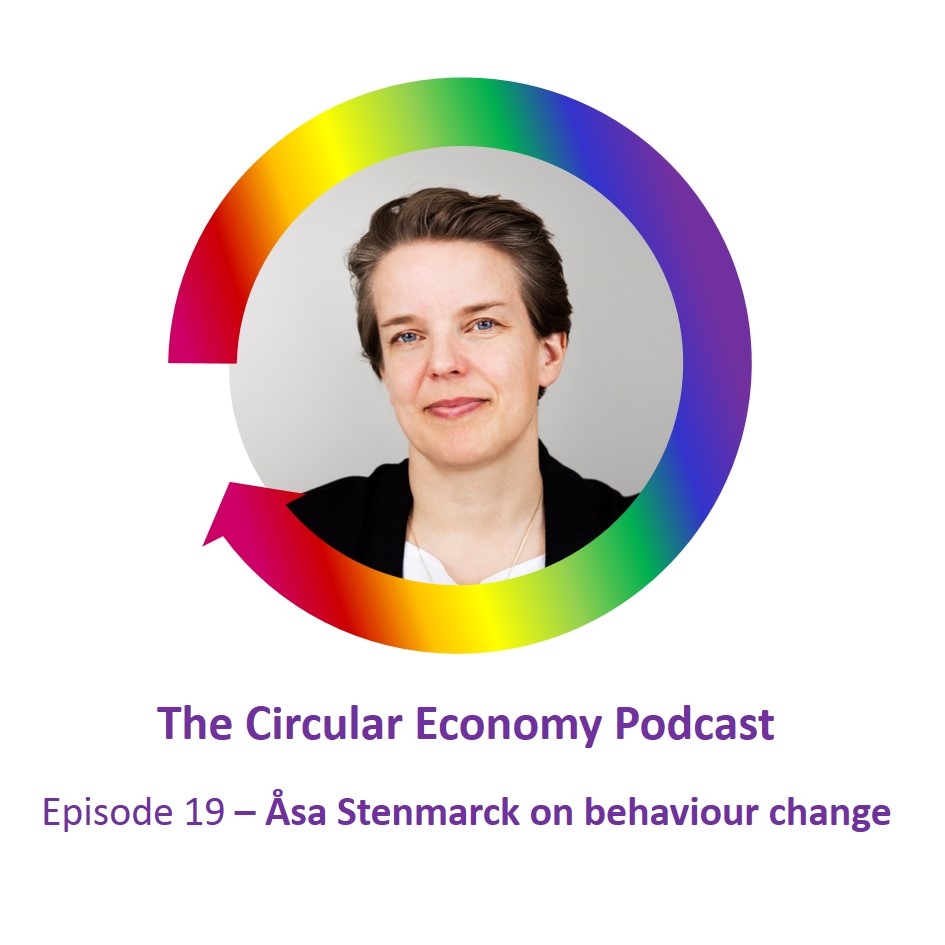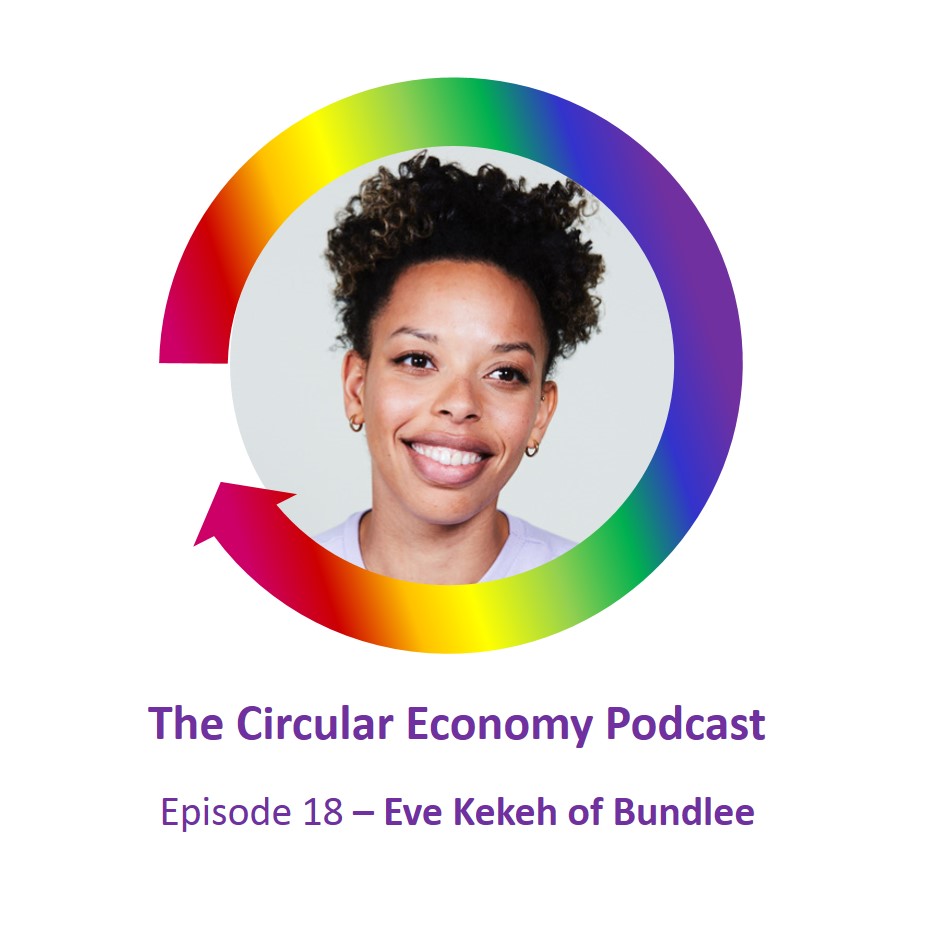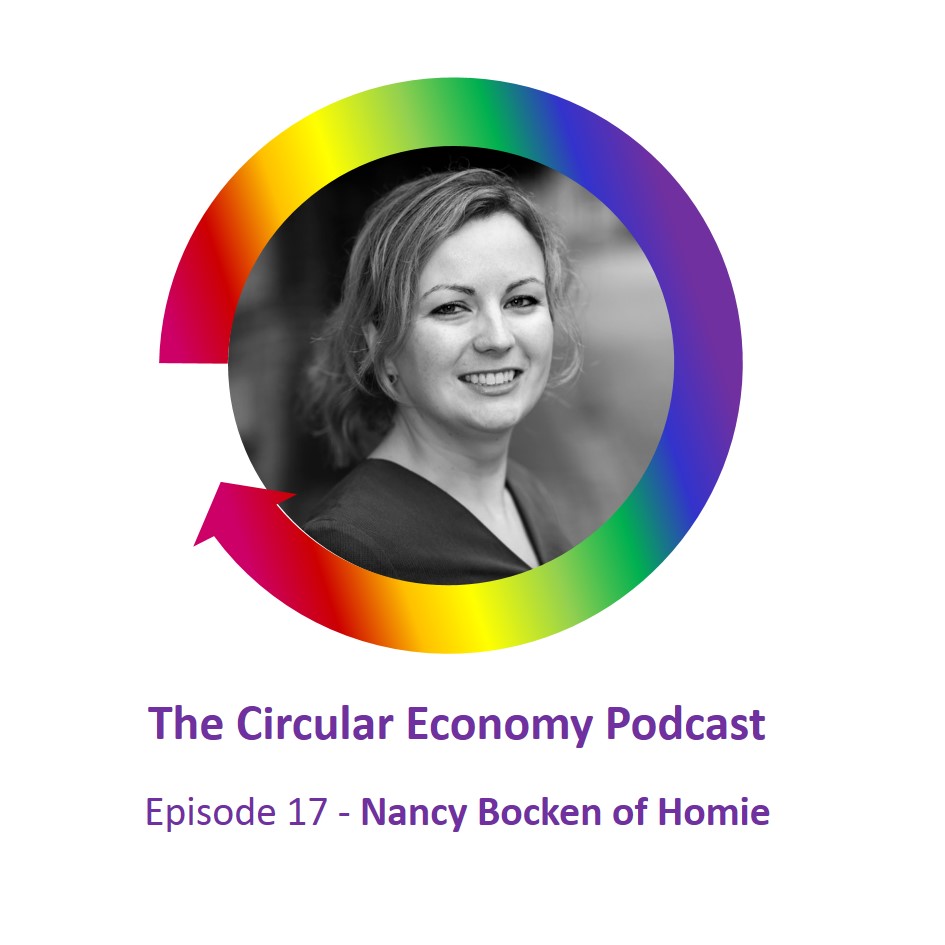Podcast: Play in new window | Download
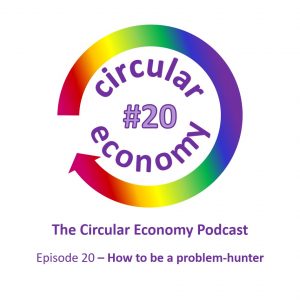
How do we find a linear problem that needs a circular economy solution? Bec Evans, author of “How to Have a Happy Hustle: the complete guide to making your ideas happen” suggests starting with what’s bugging you, and becoming an ‘avid problem collector’. We look at how our guests in the last series hunted down their linear problems and got clear on what the customer needed – the ‘job to be done’ in ‘Lean’ terms.
We also get an update on ApparelXchange’s new subscription model, and get some ‘bonus’ circular economy examples from David Greenfield (aka Dr Resources of the Circular Economy Club London).
Podcast host Catherine Weetman is a circular economy business advisor, workshop facilitator, speaker and writer. Her award-winning book, includes lots of practical examples and tips on getting started. Catherine founded Rethink Global in 2013, to help businesses use circular, sustainable approaches to build a better business (and a better world).
Stay in touch for free insights and updates…
Read on for the podcast transcript and links to the people, organisations and other resources we mention.
You can subscribe to the podcast series on iTunes, Google Podcasts, PlayerFM, Spotify, TuneIn, or search for “circular economy” in your favourite podcast app. Stay in touch to get free insights and updates, direct to your inbox…
Links we mention in the episode:
- A Circular Economy Handbook for Business and Supply Chains
- Bec Evans https://www.happyhustlebook.com/ and Beth’s talk at the RSA
- https://archive.org/details/rsa-The_Era_of_the_Side_Hustle_with_Bec_Evans
- Izzie Eriksen of ApparelXchange https://www.apparelxchange.co.uk/ on Facebook https://www.facebook.com/apparelxchangeCIC/ Twitter https://twitter.com/apparelxchange_ And Izzie Eriksen on LinkedIn https://www.linkedin.com/in/izzie-eriksen-b3a1a79/
- David Bassetti https://www.linkedin.com/in/david-bassetti-92728014/ David on Linked In https://www.linkedin.com/in/david-bassetti-92728014/ 3D Seed 3D-Seed.com Follow 3D Seed on Twitter https://twitter.com/3d_seed_bcn
- Beth Massa – Ozarka https://ozarka.biz/ ARK Reusables https://ozarka.nl/ark-reusable/ email: Beth Massa beth@ozarka.biz Ozarka on Twitter https://twitter.com/OzarkaNL Ozarka on Facebook https://www.facebook.com/ozarkanl/ Instagram instagram.com/ozarka_nl
- David Greenfield on LinkedIn com/in/dr-david-greenfield-646b6b6 and Twitter @DrResources Tech Takeback http://techtakeback.com/ SOCIAL, ENVIRONMENTAL & ECONOMIC SOLUTIONS (SOENECS) Ltd http://www.soenecs.co.uk/
- Circular Economy Club https://www.circulareconomyclub.com/
- Lucy Hughes, https://www.linkedin.com/in/lucy-hughes-32080057/ winner of the International James Dyson Award https://www.smithsonianmag.com/innovation/bioplastic-made-from-fish-scales-just-won-james-dyson-award-180973550/
- Santiago Navarro of Garcon Wines https://www.garconwines.com/
- Matilda Jarbin on LinkedIn https://www.linkedin.com/in/matilda-jarbin-39a15a58/ GIAB’s website godsinlosen.se/foretag and the shop www.returhuset.se GIAB on Linkedin: Godsinlösen
- Sophie Thomas on LinkedIn https://www.linkedin.com/in/sophie-thomas-1965a91b/
- Matthews ltd http://www.thomasmatthews.com/
- The Great Recovery Project http://www.greatrecovery.org.uk
- Nancy Bocken on LinkedIn https://www.linkedin.com/in/nancy-bocken-b7384614/
- homiepayperuse.com(Homie official website)
- @homiepayperuse (Homie on Twitter)
- Eve Kekeh of Bundlee on LinkedIn https://www.linkedin.com/in/evekekeh/
- Bundlee https://bundlee.co.uk/ Bundlee on social media https://www.instagram.com/bundleebaby/ https://www.linkedin.com/company/bundlee/about/ https://twitter.com/bundleebaby https://www.facebook.com/bundleebaby/
- Åsa Stenmarck of IVL stenmarck@ivl.se and on LinkedIn https://www.linkedin.com/in/%C3%A5sa-stenmarck-a4221118/
- IVL https://www.ivl.se
- Peter Desmond’s blog on Inclusive Capitalism https://www.rethinkglobal.info/inclusive-capitalism/
- Sean Pillot de Chenecy http://www.brandpositive.org/
Transcript
Catherine [00:58] Welcome to episode 20. I’m recording this on the 1st of February and the UK news is focused on our new status on the first day after our exit from the European Union. Also on the spread and potential impact of the Corona virus. My best wishes go out to those of you affected by that.
Today, we’re going to pick out a theme from recent episodes. One thing I noticed was the variety of ways that people were getting to grips with the problem they wanted to solve with circular approaches. I’ve been reading a brilliant book by Bec Evans, who I met recently. It’s called “How to Have a Happy Hustle: the complete guide to making your ideas happen”. And it’s aimed at those people who are looking to get fulfilment by doing something new, especially a startup or side project.
From linear problems to circular economy solutions
So how do we find a problem that needs a circular solution? Bec’s advice is to start with what’s bugging you. Now we can collect the problems we experience big or small, whether they affect one person or 1 million back, suggest we become avid problem collectors by noticing and asking other people what bugs them. By watching TV and observing other people and even on social media, she says we can make problem collecting a daily routine, challenge ourselves to record 10 problems a day and soon we’ll have a stack of problems waiting to be solved. I’ll put a link to Bec Evan’s website and her talk at the RSA in the show notes.
In Episode 11 we talked to Izzie Eriksen, founder of ApparelXchange, a social enterprise in Scotland. Izzie had noticed problems with school uniforms. Firstly that as children grow fast, the uniforms are quickly outgrown, the clothing gets a hard time and so maybe stained or damaged before it’s outgrown. This means school uniforms end up being a bit like fast fashion with a heavy production footprint and lots of waste and they’re expensive. ApparelXchange is solving this problem by developing circular business models for school uniforms and children’s clothing. Starting with a reuse offer and including sewing and repair classes in schools.
Catherine: [03:30] Izzie, welcome back and the, it’s a bit late to be saying happy new year, but last time we spoke we said we would catch up in January and see how your new ideas are coming along. You were thinking of trialling a subscription model. Where’s that got to?
Izzie: Hi Catherine. Great to talk to you again and happy new year to you as well. I think we can just get away with it cause it’s still January. So maybe the 1st of February is the cut-off. So yeah, so we ended up doing an eight-family trial of our kind of subscription model. It was really, or it was focused around school uniforms, what we were basically saying and what we offered was for people to buy the school uniform a slightly elevated price from what we normally sell it at. And with that elevated price, they could get replacements throughout the year. So that kicked off in August just before the kids went back to school up in Scotland. And the eight families had a combination of only children or several children and they took a combination of numbers of garments. And what we were trying to do with the trial was kind of create a real-life scenario where, you know, families already have garments that they using school uniform that they’re using and they really needed just some additional stuff from us.
Izzie: And eventually what we would hope is with the subscription model, they would come to us for everything. We have literally just finished the first kind of phase of that. So we went back and just before Christmas we surveyed everybody who was in the trial and we’ve got some really great feedback. So three families had already come back to us to have garments exchange. So the children had grown and that was really great. And we were also replacing some shirts that had got quite badly stained as well. So what we were getting is the really useful data that tells us, you know, almost like the loss rate that we might have over garments that we can’t reuse. But what was great is the ones that we did exchange out. We’ve probably had, you know, a reuse rate of about 70%.
Izzie: So this is all great data to help us build and understand some of the costs that we’ve got. So we will be doing another interview kind of survey with the families again, probably about Easter time and what we would expect to see probably March, April is for the families to come back to us and want to exchange again, a product for summer dresses and shorts and things like that. The other question we asked though with the survey was because we’ve just been focused on uniforms was, would they be out for a membership subscription model around other garments as well. So since we last spoke, we knew that we were very aware that we needed to kind of branch out and diversify to all school age, children’s clothing and footwear and accessories and we’ve done that. So we’ve really broadened out all of the clothing that we accept.
Izzie: It goes through the same kind of rigorous process of quality checking and, and it’s retailing in the St Enoch Centre now and online. We still have to work quite hard to kind of develop that supply chain and kind of get enough of a quality and a variation of all the different types of garments for growing children at different ages and colours and styles and everything’s so very much what we know now we need to do is increase the volume and range of stock that we’ve got and the next few months. And also have an ability to manage that within our current retail footprint at the St Enoch Centre, because that’s our main operation. So we’ve been also trying to source a second location storage processing hub and we’ve had a bit of support from kind of a local property, private sector property consultant who’s looking into that with us.
Izzie: So that’s kind of leads a little bit into the developments of it as well. But you know, what was really great about undertaking the survey work was really understanding kind of what the problems that we’re solving for customers. You know, and we had some feedback from one of our families and they are in receipt of a clothing grant, which they use for uniforms. So they receive benefits, they get clothing grant up here, all local authorities provide them in Scotland and it can be anywhere between kind of like £60 and £110. And they were really keen to carry on when we more formalize the model because they’re very keen for to know that with their budget they would have access to all the uniform that they needed over the year and that the family didn’t really need to worry about.
Izzie: Where am I going to get the money for the next size up and the jumper in the next size up, or the next size up in the skirt. So, you know, that was such valuable kind of feedback. This absolutely helps people manage their budgets.
Izzie: If you’re on a budget or you’re looking for a quality garment, that low cost and I think that might be a better route for us. So what do we got in the city that, that can help you as a, as a family.
Catherine: And just increasing that awareness.
Izzie: Yeah.
Catherine: And from what you were saying earlier, You are hoping to replicate the model in other places.
Izzie: Yes. So we, I mean at the moment, you know, I think we need to have a couple more years under our belt in terms of operations and really fine-tuning what we’re trying to do and really established the membership model.
Izzie: I think realistically, I mean, I mean I think you’ve always got to kind of look a couple of years ahead in terms of development and you know, obviously just having that ambition and that vision is really important. But I think the if we could probably replicate kind of in Edinburgh with the membership model and do it quite locally or in done that, you know, Stirling, Dundee, and try and find like-minded organizations so we can kind of license the idea to a franchise it to or either expand ourselves. Because I think one of the things we recognize with pre-worn garments and with children and with young people is that, you know, they need to try stuff on, get that touch, feel experience. And while we have an online operation, we can’t transfer the whole thing online. It’s not how this thing’s going to work.
Izzie: And, you know, I think what we see ourselves doing is really bringing, reinvigorating the high street. So saying actually, you know, this is a new opportunity to come to the high street, a slightly different experience from what you’re currently having with buy new or new products or going to a charity shop. You know, this, this is about the child being put to the centre of, of buying the garments that they wanted about them making choices and really kind of creating a hub where there’s lots of activity going on at learning about kind of repair and kind of being a part of the movement as well. So we are having some exciting conversations with the St Enoch Centre and that, you know, this is a shopping centre we’re in and Glasgow and you know, sustainability is at the core of their strategies.
Izzie: We’re looking at, you know, how we work with them as well and what kind of our offer is and how that’s quite distinct from, from other retailers in the centre and in Glasgow as a whole. So we would love to see other social enterprises co-locate where we are, other sustainable fashion makers and designers locate co-locates that actually what you create is then a bit more of a hub around, you know, more sustainable fashion opportunities basically.
Catherine: So Izzie, if people are interested in working with you, how can they get in touch?
Izzie: So look, there’s the usual channels. Go into the website. We’ve got lots of social media channels as well in terms of kind of the Instagram and our Twitter and Facebook. So track us down. We would love you to be involved if you’ve got ideas, opinions, if you’re, you know, in Cornwall somewhere, or Wales somewhere or Northern Ireland somewhere, another part of Scotland or England, you know, get in touch because we are trying to work out, we can be there for everybody. How we can maybe improve on what the online offer is.
Izzie: Yeah. And, and just really, you know, a big part of, of this movement that we’re a part of is about having friends across, across the whole of the UK. So yeah, just because we’re in Glasgow doesn’t mean we don’t want to be in contact with everybody. And spreading and spreading the news. So networking. So, yeah,
Catherine: Absolutely. Brilliant. Well, thank you very much. And we’ll put the links to ApparelXchange on the website and social media in the show notes. And let’s hope next time we catch up with you that you know, the scale is increased and you’ve got more customers and more garments and more helpers.
Izzie: Yeah, no, I know. I know. That’d be good. Lovely, Catherine. Thank you so much.
Catherine: Thanks, Izzie.
Catherine: [13:04] In Episode 12 we heard from David Bassetti of 3d Seed. In this episode, David had noticed the problem of plastic bottles, littering beaches in Mallorca and decided to find a way of helping communities, schools and businesses recycle plastic into 3D Printed products that they could design these for themselves, helping engage people in the problem of plastic waste and how to get it back into the system.
[13:34] In Episode 13, we met Beth Massa of Ozarka [Ark Reusables], and Beth was also tackling the problem of plastic waste, focusing on containers for food to go.
Beth and her husband Michael have created returnable, reusable and recyclable silicone packaging for takeaway food. Thinking about how to make it easy for people to carry the empty containers, they made them collapsible.
To make the work for the cafe’s, delis and takeaways, they made the containers in standard portion sizes. Both consumers and the outlets are overjoyed to find circular sustainable packaging options so they aren’t part of the waste problem. Consumers and the outlets are overjoyed to find circular sustainable packaging options so they aren’t contributing to the waste problem.
[14:18] In Episode 14 we talked to David Greenfield, also known as Dr Resources of Circular Economy Club London.
David told us about Tech-Takeback, a partnership he founded to get interviews, technology resources safely back into the economy. The key is safe erasure of data, meaning people can be confident that their phones, computer hard drives, tablets and so on, will be properly wiped of personal data. Tech-Takeback helps people declutter and dispose of their technology products safely and enable that technology to have a second life or be properly recycled.
Dr Resources’ favourite linear problems and circular economy solutions
David (aka Dr Resources) had lots of circular economy examples and we couldn’t fit them all into one episode. So have a listen to this bonus section.
David: [15:44] the circular economy has got so many interesting things. We, we did probably a little bit of an aside, but it was quite exciting for me. I tend to come up with lots of crazy ideas and then see if we can actually try and do them. So last year I came up with the concept of in the London circular economy week, hosting a circular economy tour of circular economy businesses on the circle line as part of Circular Economy week.
Catherine: So come on, I don’t think you tried hard enough to get enough circulars into that concept.
David: Well, I didn’t manage to get one more in – delivered by Circular Economy Club.
Catherine: Fantastic. Fantastic.
David: So I ran that this year and we went to 17 companies in the space of sort of literally a whole day, 9:30 we started with Biome. We started with Open Cell labs, a couple of companies there. We then went to the Goldfinger factory and learned how they were essentially repurposing furniture. Went along to LWARB and saw some of their accelerator companies, including Aldstone and a couple of company making gin out of potato waste. And then finished off at Sustainable Banksides where we were talking to ADBA, Right Furniture and Toast Ale amongst others. And we had 35 people spending a whole day going through all of this and they absolutely loved it. And we, we planned that well because Toast do a Free-beer Friday at their offices at five o’clock. And we’ve got there about seven, half-past four. But for me there was so much innovation going on in the circular economy space that it’s really difficult to nail something down cause there’s so many good things. Ooho are a brilliant example of redesigning.
Catherine: Yeah. And that’s, and that’s not new, is it? When did I first hear about that? 2015, I think. And it had already been going for a few years then. So yeah, we could do this.
David: It’s amazing for me. I think that I now class myself as a, I don’t think I’m an old fart yet, but I’m an older fart. I’ve been around, I can, I can make myself old by saying I was working with last millennium and that scares a lot of the youngsters I’m dealing with, but we’re seeing some really rarely interesting solutions coming up from people that have grown up with this as a problem. I think we mentioned before we started this one particular lady I had the pleasure of judging the Sussex university design awards. So this is undergrads, end of year, third-year undergrad show. Firstly, I was absolutely blown away by the level of professionalism and the way that they were designing their shows, I got asked to judge what I thought was the most or give the most circular economy award. And there was one lady who had created a plastic film replacement using fish scales and other forms of algae and all sorts of things. And she’s built a cocktail that replicated the film that you’d get in, sort of like sandwich boxes, not, but clingfilm slightly thicker than that and it was just sort of like, wow, wow, wow, wow. And good times to have this interview, it was announced in the Guardian today that she’s just won the James Dyson award for the UK and is going into the International James Dyson award. Lucy Hughes if anybody’s interested.
Catherine: No, that was great. And I was just thinking as we, as we started to get into some of those, I was thinking we could easily do a second episode just going through some of the exciting stuff that you’ve seen and kind of you know, showcasing 10 or 15 or almost doing a virtual tour of London or the Southeast or whatever. And I think this, this for me is, is one of the ways that will help move things forward much more quickly by telling people how much exciting stuff’s happening and making sure people gets why, why that’s better. It’s not just that it’s better for the planet. But you know people are creating meaningful work out of this. People are creating startup businesses. People are doing something to turn a waste into a valuable resource and re removing a waste, waste disposal cost from another business.
Catherine: All those kinds of, you know, when, when scenarios that start to get people then thinking people in business thinking, well, what could I do with my business to do something that’s more circular? Or if I’m looking to leave college and I’m wondering what to do, you know, why can’t you start something up? And there are just so, so many brilliant ideas coming forward that you know, find it. It’s really exciting. So are there any, any one of those that you would recommend as future guests for the program or somebody else that you’d recommend?
David: I think there’s, there’s, there’s one person I’ll recommend rich. He’s so passionate about this. It’s unbelievable. Other than those I’ve already mentioned a very, very nice judgment called Santiago Navarro who is the founder of Garcon Wines. Now some of your listeners might not have heard of Garcon Wine.
Catherine: I’ve heard of it quite recently and I can’t think how, but go on.
David: They have created a 100 per cent recycled and a 100 per cent recyclable wine bottle.
Catherine: Is that the square bottle as well? Is it flat? The flat bottle? Yeah. So from my, from my logistics and supply chain background, you know, that’s brilliant because otherwise there’s all that wasted space around products. You know, if you go and look at something like a Persil bottle, where it’s, you know, an angled top and a hole in the middle for the, for the dispenser capsule and you know, weird shapes and things that, that just shouts wasted waste logistics costs to me. So yeah, the flat wine bottle. Brilliant.
Catherine: There’s a couple of things that make it even more exciting. So you’ve mentioned about logistics. Absolutely. so they can get 10 bottles of wine into the same box, that six glass bottles we’re getting into. Excellent. Which is really exciting. But fundamentally they designed them so that they can be posted through the letterbox of somebody’s home. So they are now deliverable by the post.
Catherine: Are these plastic bottles there? No. Yes. Okay. That’s good. I’m just, I’m just envisaging you know, the letterbox, our letterbox and a stone floor, if it was glass!
David: You can order them. You can order them through various online retailers now and have it delivered in a cardboard box straight through your letterbox, which of course talking about logistics means that you end up avoiding one of the biggest costs around logistics, which is returns. So the theory is that you get your 100% recycled plastic wine bottle, which still tastes as good as a glass wine bottle. And it’s then fully recyclable, including the label and the lid does that, that’s it. He’d be already really good ones to chat to. Yeah. Fantastic. But yeah, very much I believe that the circular economy is about demonstrating to people the art of the possible rather than talking about the possibility only. Hmm. Yeah.
Catherine: And I think, yeah, making, making it exciting and helping people understand what’s out there and what they can choose to buy differently. Like the wine bottles and so on starts to energize people to feel that they’re making a difference in their personal lives. And that then gives you, gives you energy and inspiration to look up what’s the next thing that you can do in the next thing and so on.
Catherine: [24:27] Staying with computer technology, in Episode 15 we talked to Matilda Jarbin of GIAB in Sweden. GIAB’s founders had noticed two problems related to consumer technology, especially phones and laptops in Sweden. These technology items are often included in household insurance. So if you drop them or get them wet, you claim, the insurer would replace the item but wouldn’t ask you to return the damaged one. So the first problem is the lost value of all that unused technology which might be repairable and definitely has value for recycling. The second problem is that the consumer might not want a new replacement preferring to stick with the model they’re familiar with. And this system also cost more, meaning householders ultimately end up with higher insurance premiums. So to solve this problem, GIAB set up a system whereby making a claim means you have to return the damaged item. If it’s repairable, you have the option to have it repaired or to swap it for another pre-used phone if you want it back quickly, the insurer saves money, and GIAB helps close the loop on all that valuable technology.
Catherine: [25:46] In Episode 16 we talked to an expert in designing circular solutions, Sophie Thomas. Sophie used her experience in ethical and sustainable design in the RSA’s ground-breaking Great Recovery Project. Sophie explained the importance of thinking about the system you’re designing for, not just the object or product itself.
Sophie: Exactly. And I think this is what was happening. I mean the way that the design, the way that we’re taught as designers is very much now on the last, I would say the last decade has been very much focused on user-centred design. Which is great because obviously you don’t want to have, does product design, which doesn’t actually work for the person who needs it. But that’s not enough. You know, you need to have design which is also yes as you say, you know, can be taken apart. So the user changes, which is why we always talk about design for third or fourth life because you’re jumping seconds. So if you design for first-life, you’re designing pretty much a linear product. If you’re designing for second-life, you’re just designing for sort of part recycling probably. If you’re designing for third or fourth life, you actually take it out of its product placement as its position and you take it into something like a recovery for recycling.
Sophie: So you can get your all, you get your base materials back so you can start disassembling and you take it from being a product into, it’s actually constituent materials. So you’re, you, you stopped thinking about it as an object. You think of it as a, a line of materials that you need to get that peak at one product to come back than peak at another product come back. And you also you think about reuse, so it focuses, it, it makes you focus on different types of model of design and which is really fundamental for a circular economy. So servitization, leasing, we use all of that in the first instance before you get to the hour to fast recycling loop, which is currently what we always default to, you know, we can recycle it, which is only kind of the second, cause you always downgrade the materials, because it’s too much, additives. So I think it’s so much, and even if you don’t downgrade, you are expending an awful lot of energy and you’ve lost a lot of the value embedded in second. Exactly.
Catherine: Sophie also reminded us that it’s very expensive to find and acquire new customers. Keeping your existing customers costs around five to 10% of the expense and investment involved in finding new ones.
[28:14] Onto Episode 17, and we talked to another circular economy expert, Nancy Bocken. Nancy is a Professor at Lund university and highly-respected researcher on the circular economy, especially circular business models. She’s also the co-founder of Homie, which provides paper use home appliances. This solves the problem of having convenient access to a washing machine in your home without having to buy it. If it breaks down, Homie comes and repair it or swap it for another one. The pay per use model has other benefits: people think more carefully about when and how to wash, washing at significantly lower temperatures and on average 30% less than before.
[29:32] In Episode 18, we moved from washing clothes to the problem of clothes for fast-growing babies Eve Kekeh in London founded Bundlee to provide a sustainable service for high-quality baby-wear. After noticing how many clothes her younger siblings got through and wondering how someone so small needed so much stuff – babies go through seven sizes in the first two years and Bundlee’s rental subscription model gives parents a sustainable alternative to ‘take, make waste’, provides better quality clothes and costs less.
[30:10] We wrapped up this series by talking to Åsa Stenmark in Episode 19. Åsa is a researcher for IVL, the Swedish Environmental Research Institute. Åsa is particularly interested in fashion and food and is working on projects to better understand how we help, how we help support behaviour and she’s working on projects to better understand how we help support behaviour change. For example, making it easy to reuse takeaway food containers was it tells us that people already
As Peter Desmond noted in his blog on inclusive capitalism: back in 2001, The Economist pointed out that “consumer trust is the basis of all brand values and therefore brands have an immense incentive to retain it” – and thanks to Sean Pillot de Chenecy for pointing us to that quote. We also talked about the tendency for people to say they behave in a certain way, but not to actually do that in real life. How do you deal with that? When you’re designing solutions to the problem you observe: test, notice what’s really going on.
Bec Evans, the author of “How to Have a Happy Hustle” (who we talked about at the start) says this is the process of design research and that you should capture everything you’re witnessing, even things that don’t seem important in people’s behaviour and body language. You start with those observations and then look for patterns which can open up new insights. Insights are often the aha moment finding a truth about people’s behaviour or insights that can lead to new or better product service or ways of doing things. You start with those observations and then look for patterns which can open up new insights.
Insights can be the ‘aha’ moment, finding a truth about people’s behaviour or issues that can lead to a new or better product service or way of doing things. As I guess in this series have found the best solutions and designs have come from getting curious about the problem, understanding it from the viewpoints of all those involved and finding the true insights hidden under the surface.
Bec Evans says we can become a problem-hunter today and an inventor tomorrow.
To find out more about the circular economy, listen to Episode 1, read our guide: What is the Circular Economy or buy the book: A Circular Economy Handbook for Business and Supply Chains
Why not sign up for the latest episode and insights, straight to your inbox?
Want to find out more about the circular economy?
If you’d like to learn more about the circular economy and how it could help your business, why not listen to Episode 1, or read our guide: What is the Circular Economy?
To go deeper, you could buy Catherine’s book, A Circular Economy Handbook for Business and Supply Chains This comprehensive guide uses a bottom-up, practical approach. It includes lots of real examples from around the world, to help you really ‘get’ the circular economy. Even better, you’ll be inspired with ideas to make your own business more competitive, resilient and sustainable.
Please let us know what you think of the podcast – and we’d love it if you could leave us a review on iTunes, or wherever you find your podcasts. Or send us a Tweet: @Rethink _Global.
Podcast music
Thanks to Belinda O’Hooley and Heidi Tidow, otherwise known as the brilliant, inventive and generous folk duo, O’Hooley & Tidow for allowing me to use the instrumentals from the live version of Summat’s Brewin’ as music for the podcast. You can find the whole track (inspired by the Copper Family song “Oh Good Ale”) on their album, also called Summat’s Brewin’. Or, follow them on Twitter.
